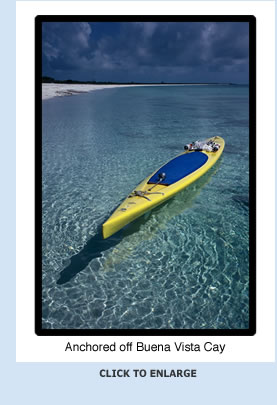 The
Jumentos, or Ragged Islands, are thirty miles southeast of Great Exuma
and the southern most islands in the Bahamas. They are pure wilderness
and may be the most remote archipelago you will ever paddle. If you
choose as I did to paddle the whole island chain, ninety miles from
Ragged Island north to Nuevitas Lighthouse, you must be entirely self-sufficient.
Or obtain an escort vessel to accompany you. Like the Exumas, the Jumentos
are bordered to the east by the Atlantic Ocean and to the west by the
aquamarine shallows known as the Banks. The Jumentos are a more extreme
environment than the Exumas. The northern Jumentos are merely jagged
limestone rocks awash in wind, waves and current. Many of the Jumentos
are so small and widely spaced apart that they offer no lee or assistance
to a paddler. Often there is no place to land or rest.
The
Jumentos, or Ragged Islands, are thirty miles southeast of Great Exuma
and the southern most islands in the Bahamas. They are pure wilderness
and may be the most remote archipelago you will ever paddle. If you
choose as I did to paddle the whole island chain, ninety miles from
Ragged Island north to Nuevitas Lighthouse, you must be entirely self-sufficient.
Or obtain an escort vessel to accompany you. Like the Exumas, the Jumentos
are bordered to the east by the Atlantic Ocean and to the west by the
aquamarine shallows known as the Banks. The Jumentos are a more extreme
environment than the Exumas. The northern Jumentos are merely jagged
limestone rocks awash in wind, waves and current. Many of the Jumentos
are so small and widely spaced apart that they offer no lee or assistance
to a paddler. Often there is no place to land or rest.
The Jumentos are sometimes visited by boaters enroute to Cuba, which
is only sixty miles to the south; they are often used as a rendezvous
for drug smuggling. Be careful of whom you paddle up and say hi to.
To reach the Jumentos, go to Nassau (see
my Exumas section). Clear with customs in Nassau and take your
board on the mail boat from Nassau to George Town, Exuma. You may
have the good fortune, while in Exuma, to meet a cruising boater
who wants to visit the Jumentos and wouldn’t mind shepherding you on a paddling trip. You can
pay through the nose and hire a yacht, such as the Luminary (Google
her) in George Town to take you to the Jumentos and accompany you
along your route. Or you can wing it and take the Ragged Island mail
boat from George Town to Duncan Town, “capital” of the
Jumentos.
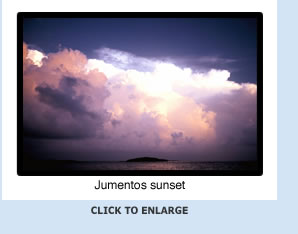 Ragged Island is the south most, largest
and only inhabited Jumento with a population in Duncan Town of
about 48. Duncan Town is a collection of wind-blasted shacks and
tiny stores that sell toilet paper and Spam. The pace of life in
the Jumentos is showcased by shady back porches full of rocking
chairs and hammocks—usually with locals
snoring in them. Entertainment in Duncan Town is The Wind and The
Sea. There is no place on Ragged Island where you cannot hear the
Atlantic Ocean thundering in. The wind sings though the long needles
of the casuarina pines. Ragged Island is the south most, largest
and only inhabited Jumento with a population in Duncan Town of
about 48. Duncan Town is a collection of wind-blasted shacks and
tiny stores that sell toilet paper and Spam. The pace of life in
the Jumentos is showcased by shady back porches full of rocking
chairs and hammocks—usually with locals
snoring in them. Entertainment in Duncan Town is The Wind and The
Sea. There is no place on Ragged Island where you cannot hear the
Atlantic Ocean thundering in. The wind sings though the long needles
of the casuarina pines.
The most colorful human in the Jumentos may
be Perseus Wilson. He is an entrepreneur, businessman and optimist.
He is tall and strong. He wears a white, long-sleeved shirt and
white long pants that contrast with his black skin. Percy is a
creative force. When an airplane crashed on Ragged Island’s tiny runway, Percy converted it
into a restaurant. Diners sit in the cockpit and fuselage and look
out at the wings. Percy built guest shacks. “For the bone fishermen
who will pay to come here,” he told me. A prized and elusive
game fish, bonefish live in the shallow waters around Ragged Island.
When I asked Percy how many customers had come to his restaurant,
he said, “Two.” Bonefishing guests? “None…but
they will come.” Percy’s clear gaze assured me that he
told the truth.
Percy is building a resort on Jamaica Cay
about fifty miles north up the Jumentos. If not patrolling his
restaurant, you will find Percy standing at the island’s north end amid a pile of building
materials that he is tranporting in his speedboat to Jamaica Cay.
Maybe Percy you will be a first guest at Percy’s resort. I
can hear him say to you, “Others will come.” Percy might
escort you up the island chain in his boat. Whatever happens, find
Perseus Wilson!
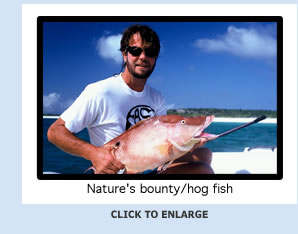 A shallow inlet filled with Percy’s bonefish slices through
the center of Ragged Island. The inlet comes in from the north side
and licks at the feet of Duncan Town. If you are sure that you are
outfitted for your paddling tour (Remember that it is ninety miles
from Ragged Island to Nuevitas lighthouse, and that once you get
there you have to get back to civilization.) paddle north from the
Duncan Town inlet. The beauty of clear water and colorful fish—and
the east wind—will strike you. Wind in the Jumentos blows southeast,
sometimes northeast and sometimes just east at seldom less than twenty
knots. In a day the wind can shift directions many times. A shallow inlet filled with Percy’s bonefish slices through
the center of Ragged Island. The inlet comes in from the north side
and licks at the feet of Duncan Town. If you are sure that you are
outfitted for your paddling tour (Remember that it is ninety miles
from Ragged Island to Nuevitas lighthouse, and that once you get
there you have to get back to civilization.) paddle north from the
Duncan Town inlet. The beauty of clear water and colorful fish—and
the east wind—will strike you. Wind in the Jumentos blows southeast,
sometimes northeast and sometimes just east at seldom less than twenty
knots. In a day the wind can shift directions many times.
A good goal for a first day of paddling is to reach Nurse Cay, which
is twenty miles north of Ragged Island. On your way to Nurse Cay,
you pass the largest and most hospitable Jumentos: Hog Cay, Maycock,
Margaret and Double Breasted Cays (you should have a nice set of
waterproof charts that you brought from Nassau ) Leave all Jumentos
well to starboard. Keep clear of the cuts between islands. Tidal
current floods into the Atlantic Ocean from the Banks and back again.
Changing tides produce eight-knot current and steep standing waves.
Once you get caught in a system like this, you will make no headway
as a paddler.
You will probably see sharks in the Jumentos, large hammerheads,
bull sharks, tigers and nurse sharks. The Ragged Islands are a healthy
marine ecosystem and such health is usually guarded by large predators.
The sharks frequent the cuts. If you see a shark, I would advise
pulling your hands and feet out of the water. Float on your board
and wait until the shark decides that there are more interesting
things around than you.
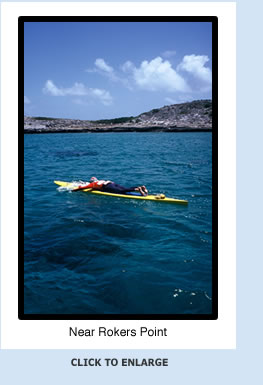 As you pass Raccoon and Buena Vista Cays,
make a beach stop. The beaches are polished silver, trackless and
spangled with rare, delicate shells. Rainbow-hued fish that aren’t afraid of you will nose
in to your feet as you wade and beach comb. Unless you have an escort
vessel parked just offshore waiting to feed you lunch (fresh porgy,
snapper, hog fish, conch) you won’t see another soul. Even
conch fishermen who come in from Spanish Wells, Bahamas, to collect
conch, are rare. You are out there alone amid the vast tropical sapphires
of sky and sea. As you pass Raccoon and Buena Vista Cays,
make a beach stop. The beaches are polished silver, trackless and
spangled with rare, delicate shells. Rainbow-hued fish that aren’t afraid of you will nose
in to your feet as you wade and beach comb. Unless you have an escort
vessel parked just offshore waiting to feed you lunch (fresh porgy,
snapper, hog fish, conch) you won’t see another soul. Even
conch fishermen who come in from Spanish Wells, Bahamas, to collect
conch, are rare. You are out there alone amid the vast tropical sapphires
of sky and sea.
Nurse Cay is gateway to your first paddling
crucible, the fifteen-mile Nurse Channel between Nurse and Jamaica
Cay (site of Percy’s
proposed resort). If you are roughing it, bringing your own food
and gear, you can sleep on the beach at Nurse Cay. Make sure the
mongooses and rats don’t steal your food or your fingertips.
Other than its predatory rodents, Nurse Cay is a tropical idyll with
palm trees, gleaming sand and plenty of clear ocean to bask in.
It is fifteen miles between Nurse Cay and
Jamaica Cay. By the time you’ve battled wind and current, you will paddle more than
twenty miles. The wind bellows through this channel and builds up
pyramid-size waves as it tugs against the current. There are few
landmarks to guide you in Nurse Channel. You’d better have
a GPS, or an escort vessel captain who doesn’t mind bellowing
directions above a cataclysm of wind and waves. The biggest above-water
island—a rock—that you will see is Seal Cay about three
quarters of your way to Jamaica Cay. Make sure your course is good
in Nurse Channel or you’ll end up in Africa or Cuba.
If you have been strong and insane enough
to reach Jamaica Cay, you can camp there or have your chase boat
anchor offshore. Like Nurse Cay, Jamaica Cay has a perfect beach
and superior tropical ambiance (or Percy wouldn’t build there) However, nascent as
Percy’s venture on Jamaica Cay is, he has posted guards to
keep folks from stealing his supplies and equipment. If Percy isn’t
there, you won’t find welcome on Jamaica Cay.
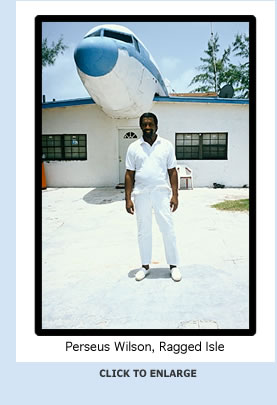 Now you face the nine-mile Man of War channel
on your way to Man of War and Flamingo Cays. Shorter than Nurse
Channel, Man of War Channel is more intense. Current, ocean swell,
wind and “set” (the
speed at which you are pulled off course) are extremely forceful.
Man of War Cay is just a surging rock, and keeping on course to it
is as hard as walking a tightrope in a hurricane. Now you face the nine-mile Man of War channel
on your way to Man of War and Flamingo Cays. Shorter than Nurse
Channel, Man of War Channel is more intense. Current, ocean swell,
wind and “set” (the
speed at which you are pulled off course) are extremely forceful.
Man of War Cay is just a surging rock, and keeping on course to it
is as hard as walking a tightrope in a hurricane.
Flamingo Cay is a solid island with sandy
beaches, free even of Percy’s ambitions. Flamingo offers
good stomping ground for feet that want to walk. You will see a
few ruined walls and the beginnings of structures built and abandoned
perhaps by folks who had a dream then realized that paradise can
be isolating. Enjoy, because soon you will follow the tiny rocks
that stick from the white ocean foam like dark teeth across a ten-mile
channel to Water Cay.
Water Cay, the Jumentos’s last solid stand, is long and skinny.
The island provides windy views of the rough, blue-black Atlantic
Ocean that smacks into its eastern shore. Mostly, Its jagged limestone
platform reminds you that bare feet are vulnerable, and that you
are “out there” in the Jumentos with nothing and nobody
but yourself.
Paddling from Water Cay to Nuevitas Lighthouse,
the end of the island chain is like watching the heart monitor
of a dying patient. Even the names—Stony Cay, No Bush Cay and Wet Cay—of the last
few rocks in the Jumentos suggest desperation and demise, the last
heartbeats of the dying. When I saw the lighthouse—a tiny stone
pillar mounted on a rock in the cobalt sea—I felt sad.
The Jumentos are as healthy as any wilderness can be today, but
they are finite, as countable as your fingers and toes and as mortal.
Love the Jumentos; protect them.
** To learn more about the Jumentos, or Ragged islands, please consult
the Explorer Chartbook, Exumas and Ragged Islands by Monty and Sara
Lewis
|
